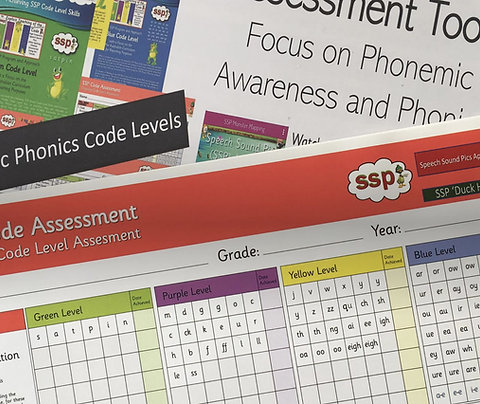Use the SSP Speech Sound Play Plan before teaching any phonics programme, not just the Speech Sound Pics Approach, to screen for dyslexia risk by assessing phonemic awareness and phonological working memory. We are identifying the 1 in 4 children at risk of struggling to learn phonics before phonics instruction begins.
IPA-aligned Phonemies are Speech Sound Monsters®. They show children the speech sound value of letters. Letters are pictures of speech sounds (Speech Sound Pics®), making word mapping visual, linguistic, and fun. Reading for pleasure by 7!

The Year One Phonics Screening Check
Even if children know all the Core Code GPCs (most of which are tested in the PSC), they still need to be able to work out the rest of the orthographic code or they will not become fluent readers. This is why passing the PSC by the end of Year 1 should not be the goal. The real goal should be for children to know these GPCs before leaving Reception (I can show you how this is easy to achieve, in any socio-economic area) and begin self-teaching during Year 1, developing independence and confidence when reading stories, not only those considered ‘decodable’ because they use Core Code GPCs. They must map words bi-directionally.
We need to make all text decodable to the child. We can do this by ensuring they have access to word mapping technology that reveals the orthographic code in any word they encounter. Start the mapped stories at SpeedieReadies.com from Term 2 of Reception. This supports self-teaching and helps children move towards orthographic mapping, the stage when they can read without having to stop and decode each word. The more they read, the more words they store, and because they understand the mapping, they can transfer that knowledge to new words.
Vocabulary knowledge also matters. Children need to know how words sound when spoken in order to assign the correct speech sounds and graphemes when using partial decoding - so that they can apply Set for Variability. Synthetic phonics programmes do offer opportunities for partial decoding and the development of SfV.
Emma Hartnell-Baker
Parents and teachers are told, in reference to the SSP programmes that are validated, that
“A complete programme is one that provides all that is essential to teach SSP to children in the Reception and Key Stage 1 years of mainstream primary schools, up to or beyond the standards expected by the national curriculum, and provides sufficient support for them to become fluent readers.”
This is not true.
What is the Year One Phonics Screener Check?
The Year 1 Phonics Screening Check is a statutory assessment used in England each June to gauge how well children can decode simple words. Each pupil reads 40 items, half real words and half pseudo words, while a teacher records whether the child can pronounce them correctly.
The marking criteria uses the IPA phonetic symbols to denote the 'acceptable pronunciations' for the pseudo words.
Although presented as a measure of early reading skill, the check covers only about 90 grapheme–phoneme correspondences (GPCs) out of the 350 plus known to skilled readers. These are covered in the Speech Sound Pics (SSP) Approach Core Code - the four Code Levels seen on the SSP chants strip. It simply tests whether a child can look at a GPC, say the “expected” sound, and blend those sounds into a word. When a child struggles, the test does not reveal the reason. It cannot tell whether the difficulty lies in recalling the phoneme, blending the sounds, or something else entirely. It also offers no information about a child’s ability to encode (spell from sounds) or about phonological working memory. These are risk factors for dyslexia.
Furthermore, children with strong orthographic knowledge, such as those learning with the Speech Sound Pics approach, must be told to use only the “core code” when reading the pseudo words. Otherwise they may give several plausible pronunciations, which is actually a sign of advanced word knowledge but is not allowed within the assessment.
Because of these limits, the Phonics Screening Check provides little diagnostic value for identifying dyslexia or for guiding targeted support. It is both too narrow and too late to give teachers the insight they need.
Children using the SSP Approach are checked once they have completed the four Code Levels, and their results are added to their records. For some this occurs in Reception term one, most are ready before the end of Reception, while others who need more time (around 10%) might not be ready until the middle of Year 1. Children are not expected to be learning the core code at the end of Year 1 unless there is a significant intellectual impairment. SSP teachers also uses our own Assessment Tool to check letter formation, decoding fluency, and comprehension at each Code Level.




Use MyWordz® as a Phonics Spell Checker! By typing the word using the Phonemies keyboard you check they can spell (encode) the words. This will align with the DfE Writing Framework.


One in four children in England is failing to learn to read and spell easily and needs the NeuroReadies Learning Pathway instead. It is far easier to implement in the early years (EYFS) and KS1. Please do not wait until they have struggled with synthetic phonics for two years. If they fail the Phonics Screening Check at the end of Year 1, they need this as a matter of urgency, through Word Mapping Mastery which is achieved by introducing chidren to the Monster Mapped version of the One, Two, Three and Away! (Village with Three Corners) reading series over the summer holidays. We can support you with that. We show them how the speech sounds, spelling and meaning connect.
Get in touch with us at the Early Dyslexia Screening Centre in West Parley, Ferndown. We also support families online.


